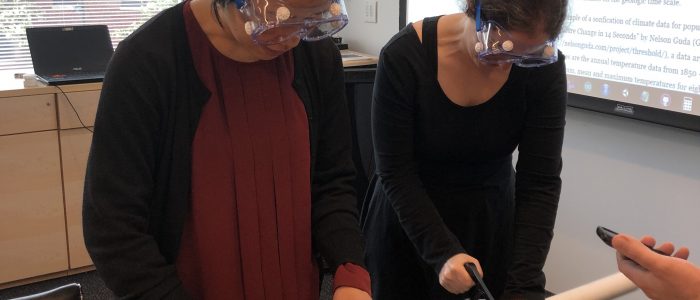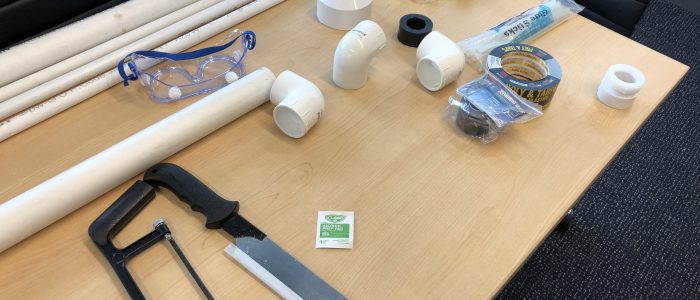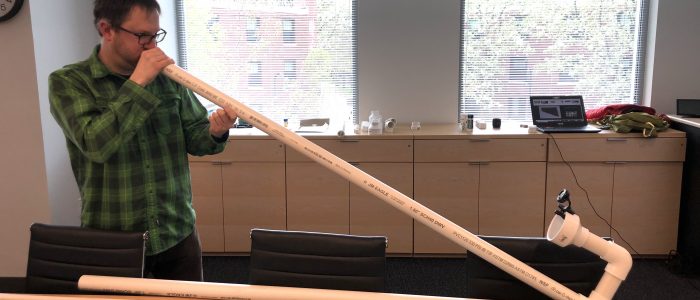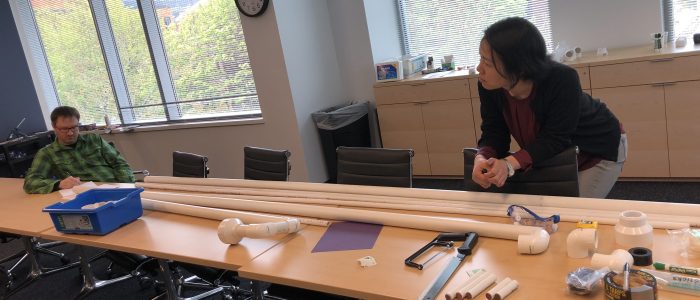“Digeridata” and the Music of Climate Change
by Kate Stringer
As summer approaches, the MIT pK-12 community starts building up a head of steam–or more appropriately, STEAM. As the time draws near to lead what has become an expanding roster of STEAM camps at schools across the globe, curriculum developers and program managers begin charging excitedly all over campus in search of resources, collaborators, and really cool ideas. Feverishly, we start gathering power tools, ordering strange conglomerations of disparate materials, and occasionally, we make some very loud, decidedly indelicate noises.
Visitors to MIT Open Learning could attest to that last point while wandering the halls on a Wednesday in early May, as members of the Action Group welcomed passersby to drop into the Jupiter conference room and help build a digeridoo. What does an Indigenous Australian wind instrument have to do with teaching science to middle-school students? We’re glad you asked.
In the module “Digeridata,” created for the 2019 edition of the STEAM Camp that will take place at in the Chinese International School in Hong Kong, curriculum developer Adam Santone has dreamed up an innovative way to combine music with lessons about climate change and ways to engage with cultural studies. Using inexpensive, easily sourced PVC pipe of varying widths, the students are charged with constructing pan flutes and digeridoos. Santone draws attention to the cultural provenance of both instruments – the pan flute was chosen because of its long heritage as a part of Chinese folk music, and the module incorporates a short history of the digeridoo, one of the oldest instruments in the world still in widespread use.
The theme of this year’s camp is “Air,” and this module fits the bill perfectly–after a few attempts at playing the digeridoo, we, the staff, found ourselves thoroughly winded. We also discovered that making a melodious sound come out of a wide-mouthed piece of PVC pipe is no mean feat. The instrument is blown through a mouthpiece traditionally molded in beeswax (though for this module, plastic joints can be substituted.) The lips must be loose but still agile, and given the large size of the pipe, the player must expel an enormous amount of air at a go, a phenomenon achieved continuously only by using the technique of circular breathing. When played correctly, the instrument produces a marvelously bold series of drones whose pitch depend largely on the length of the pipe; in the hands of this author, the sound produced more closely resembled the sputtering of a Model-T Ford.
The module involves more than a simple exploration of acoustics: Santone intends to find ways to musicalize data on climate change, relating pitch or dynamics to phenomena such as rising levels of carbon dioxide in the atmosphere, for example. His course materials, still in development, use examples of existing compositions built on similar systems of data points as music notation.
And of course, there’s math involved. While testing out the pan flutes, pK-12 Action Group Program Coordinator Joe Diaz studiously wrote out the relationship between lengths of pipe and pitch, tuning the instrument according to the Western diatonic system. By the end of the morning, the group had achieved a flute that could play very near approximations of the first five pitches of the C major scale.
Later that week, Diaz traveled to Hong Kong to meet with educators and playtest “Digeridata” and an additional three modules that will make up the camp’s curriculum. The additional courses involve a wide variety of interpretations of the “Air’ theme: in “Animals and Aerodynamics,” Diaz has created a program that invites students to consider the influence of nature on man-made aircraft and construct flying apparatuses of their own inspired by animals. In “Water Rockets” Edgerton Center’s Yashasvi Raj takes the classic bottle rocket to the next level, encouraging trial-and-error as students learn scientific laws while designing, testing, and redesigning their projectiles. Finally, Devora Najjar and Avery Normandin leave Earth’s atmosphere entirely in “Fun with Satellites,” which uses open source satellite data to teach students how maps can be analyzed to monitor crop health, measure deforestation and reforestation, or estimate amounts of carbon stockpiled in vegetation.
The program this July/August will mark the third year in a row that MIT will offer a STEAM camp at the Chinese International School, continuing a collaboration with Catalyst Education Lab. Also this summer, MIT STEAM Camps will journey to Greece for the first time ever, teaching modules at the Moraitis School in Athens from late June to early July, sponsored by the nonprofit organization Mathisi Initiative.
Updated 08/27/2019





Comments are closed.